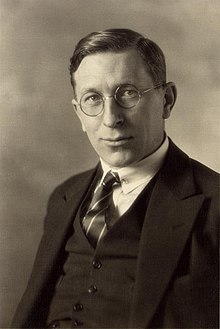Frederick Banting | |
|---|---|
 Banting in 1923 | |
| Born | November 14, 1891 Essa, Ontario, Canada |
| Died | February 21, 1941 (aged 49) Near Musgrave Harbour, Dominion of Newfoundland |
| Burial place | Mount Pleasant Cemetery |
| Education | University of Toronto (MB, MD) |
| Known for | Discovery of insulin |
| Spouses |
|
| Awards |
|
| Scientific career | |
| Fields | Pharmacology |
| Institutions | University of Western Ontario University of Toronto |
| Notable students | Charles Best |
| Military career | |
| Service | Royal Canadian Army Medical Corps |
| Years of service | 1915–1919[1] |
| Rank | Captain[2] |
| Battles / wars | |
| Awards | Military Cross (1919) |
| Signature | |
 | |
Sir Frederick Grant Banting KBE MC FRS FRSC FRCS FRCP[3][4][5] (November 14, 1891 – February 21, 1941) was a Canadian pharmacologist, orthopedist, and field surgeon.[6] For his co-discovery of insulin and its therapeutic potential, Banting was awarded the Nobel Prize in Physiology or Medicine with John Macleod.[7]
Banting and his student, Charles Best, isolated insulin at the University of Toronto in the lab of Scottish physiologist John Macleod.[8] When he and Macleod received the 1923 Nobel Prize in Physiology or Medicine, Banting shared the honours and award money with Best. That same year, the government of Canada granted Banting a lifetime annuity to continue his work.[9] Frederick Banting, who received the Nobel Prize at age 32, is the youngest Nobel laureate for Physiology/Medicine.[10]
- ^ Collip 1941, p. 473.
- ^ Bliss 1992, p. 39.
- ^ Best 1942.
- ^ "Sir Frederick Grant Banting | RCP Museum". Royal College of Physicians. Retrieved February 25, 2024.
- ^ Bliss 1992, p. 214–215.
- ^ "Frederick Grant Banting". Library and Archives Canada. February 24, 2015. Archived from the original on April 20, 2016. Retrieved April 4, 2016.
- ^ "Frederick Grant Banting (1891–1941) Codiscoverer of Insulin". Journal of the American Medical Association. 198 (6): 660–61. 1966. doi:10.1001/jama.1966.03110190142041.
- ^ "Frederick Grant Banting". Oxford Reference. Retrieved February 24, 2024.
- ^ Toronto Daily Star (June 28, 1923). "Canada rewards Banting's service. Young physician will receive $7,500 yearly from federal treasury". University of Toronto Libraries.
- ^ "Nobel Laureates by Age". Nobelprize.org. Nobel Media AB. Retrieved April 3, 2016.